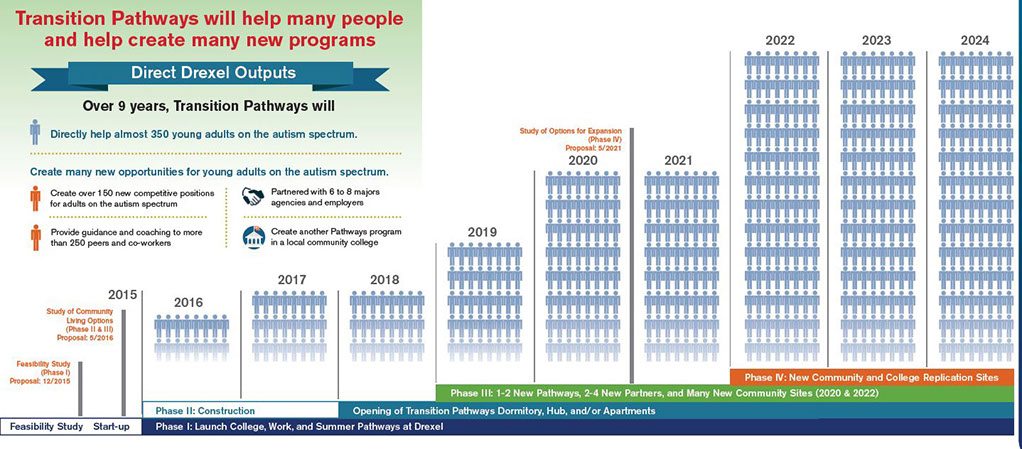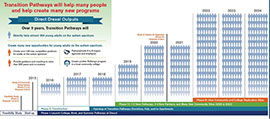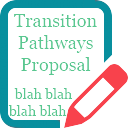 Phased approach to expansion, replication, and accountability
Phased approach to expansion, replication, and accountability
December 30, 2016
There is little research documenting how to create innovative, community-based programs of services; there is virtually no research on how to begin to scale this up to meet the needs of a population. Ambitious program development requires extensive time and planning, and so I recommended that we launch our program in phases. Those inexperienced with significant program development often over-commit to funders in their proposals or during the launch phase, for example, because they under-estimate the time and effort needed to bring new staff on board, identify opportunities and establish consensus with partners, and address the inevitable surprises.
 Launching a complex program in phases helps to maintain your focus on specific goals, and to document progress for funders considering new investments. This phased approach helps to maintain focus on specific goals and stay in budget. By carefully evaluating what we could accomplish each year, I adjusted goals and a timeline for each phase so that we could maintain momentum with the same core team, and ensure stable staffing and funding. This phased expansion is summarized in the figure provided below and included in the proposal to the foundation. These phases also proved useful in modeling how I would decrease program costs over time.
Launching a complex program in phases helps to maintain your focus on specific goals, and to document progress for funders considering new investments. This phased approach helps to maintain focus on specific goals and stay in budget. By carefully evaluating what we could accomplish each year, I adjusted goals and a timeline for each phase so that we could maintain momentum with the same core team, and ensure stable staffing and funding. This phased expansion is summarized in the figure provided below and included in the proposal to the foundation. These phases also proved useful in modeling how I would decrease program costs over time.
1. Feasibility Study
The goal of the Feasibility Study Phase was to develop a specific 5-10 year funding proposal, potentially including construction of new facility to house the program, within the very broad parameters established as part of the Feasibility Study proposal developed by Drexel in collaboration with the funder. With my colleagues, we narrowed these parameters somewhat (for example, beginning the program during the last year of high school, establishing Work and College Pathways, and so on). Otherwise, I was responsible for identifying and evaluating all other aspects of program characteristics, recommending the design of the program, and writing the funding proposal (with some feedback from my colleagues) which resulted in the gift in December 2015. Once funded, my focus shifted to finalizing the program model in preparation for a September 2016 launch for the first cohort of 16 students to be enrolled for two years: formalizing agreements with partners, establishing an initial fee structure, hiring key program staff, reviewing applicants, establishing a daily student schedule identify internship sites within Drexel, recruit and train peer mentors, and so on.
2. Launch
The goal of the two-year Launch Phase would be to demonstrate that we can bring at least 16 students into the comprehensive College and Work Pathways in September 2016 and again in 2017, using a fee structure that is minimally burdensome to low income families. During this phase, we would also seek to launch specific program development initiatives intended to supplement our core curriculum (a person-centered planning model, and a self-advocacy curriculum), and the other program development initiatives identified with each partner (described above). If a building renovation was funded, I would also expect to finalize the design of a residential living option with an associated outreach program for adults on the spectrum already living in the community. I also expected to finalize a fee structure, including the residential living portion if needed.
3. Expansion
The goal of the Expansion Phase would be to expand the program to serve twice as many students, and potentially launch an on-campus residential living option and associated community outreach program (projected for September 2018). The timing of the expansion phase would allow core program components to be established and tested over a two year period, before scaling up further and seeking to cut per-student cost associated with program development in half. The increase in core staff during this phase could give us the flexibility to create a pipeline of core professionals in teaching and job coaching, and then build and sustain their expertise in anticipation of our next step, replication.
4. Replication / Consolidation
Beginning in September 2020, one goal of the Replication or Consolidation Phase would be to wind down the program development support, and complete the shifting of these responsibilities back onto the shoulders of partner agencies, using the remaining funding over a 4-6 month period (consolidation). Demonstrating right-sized satellite sites balances the need to control costs while increasing overall capacity. This would also be a critical but often overlooked phase of program incubation, during which management of all day to day operations of existing sites would be shifted over to partner agencies with our support. A possible alternative may emerge should there be unused funding to roll over into a 6th or even a 7th year. In this case, we would fund the program development needed to support the creation of new work and college sites outside of Drexel. This latter option would have increased the total number of students impacted and driven the per-student cost down by another 30-50% relative to the previous phase. Replication could become an option either through cost savings accrued through the use of Medicaid Waiver funds to offset the costs of peer mentors, or the extension of the current gift.


Figure: Phased Expansion
Related Content
On this site
Guideposts
![]() Simple Steps Creating right-sized satellite sites increases overall capacity, improves access, and sets the stage for program replication.
Simple Steps Creating right-sized satellite sites increases overall capacity, improves access, and sets the stage for program replication.
![]() Simple Steps Create a pipeline of core professionals, and assemble the resources needed to build and sustain their expertise
Simple Steps Create a pipeline of core professionals, and assemble the resources needed to build and sustain their expertise
![]() Other Lessons With long-term planning and support, a university can incubate new programs of services and training for the community
Other Lessons With long-term planning and support, a university can incubate new programs of services and training for the community
![]() Other Lessons To expand competence or to increase capacity, you must cultivate new experts recruited within the organization
Other Lessons To expand competence or to increase capacity, you must cultivate new experts recruited within the organization
X








